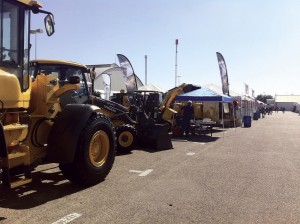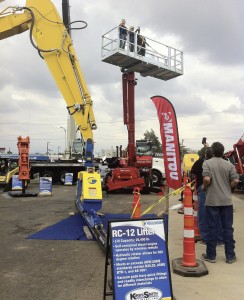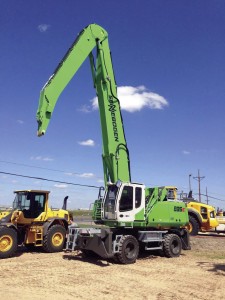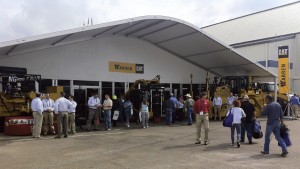The big boom has created big business for the rental industry.
By Shanti Terry
In the oil and gas industry, it’s a well-known fact that the rental industry is big business. With big companies, big equipment, and big benefits for renters, rental companies stand to make big bucks if they can overcome a few big challenges and keep up with market demands. It may sound like easy street, since this boom is keeping everyone so busy. However, a closer look reveals, as always, there’s more to the story than meets the eye. We spoke with three company giants of the rental industry for the Permian Basin and surrounding areas, picking their brains about what it takes to play the renting game and win. We found that you’ve got to pay to play, and surviving is anything but easy.
Big Companies
ASCO, Kirby-Smith, and Warren Cat are big names in the equipment rental world. None of them are strangers to the hot and heavy demands of the oilfield industry, and they have the resources and the know-how to stay ahead of the curve.
ASCO is a full service rental company in addition to an equipment dealership for the construction and industrial markets. The company’s original acquisition costs range from 160 to 200 million dollars, but the number moves around quite often because of equipment sales. According to company CEO, Brax Wright, ASCO is currently the renowned Case construction dealer and more for almost all of West Texas.
“Across the state in West Texas, we’re a Case dealer, we’re a Volvo dealer, we’re a Bobcat dealer, we’re a JCB dealer, and much more. We’ve got 22 locations and we handle a whole host of other lines through our rental division, including JLG and Genie Aerial lift equipment,” says Wright.
Kirby Smith is a 31 Year old, privately owned rental company that services the Permian Basin and beyond. The company has 10 locations that service customers as far north as St. Louis, and as far south as Odessa, Texas. Of the 2,500 pieces of equipment the company has in inventory, 25 percent of that number is being rented right here in the Permian Basin.
George Denny, Branch Manager for Kirby Smith’s Odessa location says, “We only handle the best companies that manufacture—National being one, along with Komatsu and a fork lift line called Manitou. We’ve got one of the largest equipment and crane rental fleets in a three-state area, and we rent from 800 lb skid steers up to 150,000 lb dozers and excavators.”
Warren Cat began its relationship with Caterpillar (which specializes in heavy construction equipment and engines) in 1971, and the company has never looked back. They carry Caterpillar equipment almost exclusively.
Tommy Reynolds, Rental Manager of Rental and Used Equipment in Midland, Texas says, “We’ve got locations that service all of West Texas, the Panhandle, and the state of Oklahoma. Across that region, we have over 4,000 units in our rental inventory. For the oil patch, we specialize in earth moving equipment, providing dozers, motor graders, excavators, soil compactors, generator sets, air compressors, and more.”
As you can see, each company has done much more than excel at achieving success. Why? Because they know what it takes to progress. Here are the top things their company representatives had to say about how they’ve managed to keep up and get ahead.
Big Challenges
Recruiting and keeping good personnel
Brax Wright says one of the hurdles on the road to success is choosing and keeping good people in this boom. “People are a huge challenge, with the oil field shaking and baking. Some companies have no limit to what they can pay someone, and all the rest of us do. So keeping your good people and hiring and recruiting additional good people is one of the challenges we face.”
It might be a challenge but ASCO seems to have definitely stumbled onto a solution, as they continue to grow.
Meanwhile, Kirby-Smith has upped their personnel too. “We’ve added six additional people to staff up the rental department as well as our service crew. We are also adding an additional parts person and we are in the process of hiring a new sales rep for the Permian Basin area,” says Denny.
Managing growth as needed
Managing growth is twofold in regards to the rental game. Not only do companies have to grow their personnel, they also have to manage keeping the right amount and type of inventory on hand to meet the insatiable appetites of their customers.
Tommy Reynolds of Warren Cat says, “The primary thing about the boom is being able to provide the equipment that’s needed out there. We’ve grown our rental fleet significantly to keep up with demand. As busy as it is, with all the new people getting in the business every day, the resources required to keep up with the growth have really had us working hard.”
ASCO’s Brax Wright’s isn’t far off with his response, saying, “It’s just amazing what it costs to feed this beast today. We’ll add close to 70 or 80 million dollar’s worth of equipment to our rental fleet new this year. We just keep doing that. The demand just continues to increase, so the demand for us to continually add to our rental fleet continues to increase.”
Speed and Agility: Unparalleled Service
Speed
Even after a company manages to get a good hold of their personnel and they’re fully stocked with a great amount of equipment, satisfying customer’s needs quickly can present a serious problem.
Tommy Reynold’s says it best: “Customers have a high expectation for quality and up time. So units out in the field, if they go down, they want it fixed immediately. It’s difficult for anyone to do in this environment, but our team does a great job.”
Agility
We all know what speed looks like when providing great customer service, but what meaning does “agile” take on in reference to the subject? In the rental industry, it looks like a team of technicians and other service personnel that are highly trained and ever ready to take care of problems that can occur. To accomplish this feat, extensive training is required. That training may be a bit expensive, but, according to Denny, it’s well worth it. “This whole rental success has to do with parts and services, period. You have to invest in highly trained, dedicated technicians. Kirby Smith Machinery has spent 1.8 million dollars year-to-date on training technicians. They go out and fix issues.”
Reynolds and Wright also expressed the importance of having well trained staff. All three of these rental companies, of course, provide their own service teams. Doing so allows for both speed and agility as they can fix issues on or off site, and, if necessary, swap machines out for their customers. The goal is to give customers as much “up time” as possible, whatever it takes.

ASCO was one of a handful of rental specialists to exhibit at the Permian
Basin International Oil Show in Odessa in October.
Big Equipment
Keeping up with the demands of the oil and gas industry require that companies keep their inventory immaculate and up to date. Customers will always need to rent tried and true products, but they also love access to the “latest and greatest” tools. ASCO, Kirby- Smith, and Warren CAT all keep fresh new stock flowing in for their customers. With the advancement of technology today, rental companies are now carrying items that can truly revolutionize the industry. With products like those they mentioned to us, customers certainly won’t be disappointed.
Warren CAT’s Caterpillar CG137-12 Gas Genset
If you live in the oil patch, you’ve likely seen the many giant flares that burn off natural gas. Up to this point, the gas has been viewed as a nuisance, but that isn’t the case anymore. Warren Cat’s Power Solutions Manager, Brad Murdock, proudly stepped in to introduce us to the company latest generator. It’s called the CG137-12 Gas Genset, and it’s putting that “nuisance” natural gas to work for customers.
“The use of portable generators is not new to the oil and gas business,” says Murdock. “Diesel generators have been utilized for many years in a variety of applications across the oil patch. Although diesel generators have proven to be a reliable alternative to grid power, it comes at a price. The cost of diesel and the associated transportation charges can be exorbitant for operators. For example, a 400kW diesel genset, which delivers the same power output as the CG137-12, will cost you as much as $800K more per year to fuel compared to the natural gas unit. That number doesn’t include the cost to have the diesel delivered to the well site and assumes that the natural gas is purchased at the current Spot prices. In many cases, this gas comes at little to no cost to the operator and is abundantly available whenever they need it, wherever they need it. It’s real simple—our customers want an affordable yet reliable alternative to grid power and that is what we are able to provide with our range of 50kW-1,500kW natural gas generators.”
ASCO’s Vast Array: The Sennebogen and More
ASCO is branching out a bit when it comes to purchasing new technology and equipment to rent and sell to their customers. One thing is for certain about ASCO, it’s that customers will never be able to complain about a lack of variety. As CEO Wright says, “The latest line we picked up, which is not particularly an oilfield line, is Sennebogen. It’s a scrap material handling unit that’s built somewhat like an excavator. It works in scrap metal yards, picking up giant loads of scrap metal and swinging around to drop it into a shredder, whatever you need. We’re proud of every line we carry and promote in the oilfield. We have a huge aerial lift fleet, and those are being used more and more in the oilfield. The drive behind it is safety, trying to keep the roustabout and pusher from having to climb up on pump jacks and rigs. One of our biggest product lines out in the oilfield is the Telescopic Material Handler (TMH) with a shooting boom. The oilfield is by far the biggest user of that product line. Oilfield rental is a very big part of our business and is very important to us, but we rent to almost any industry and any construction/contracting type job.”

Kirby Smith’s Vacuworx system, seen here, lifts objects using
a vaccuum technique that prevents scarring of the object.
Kirby Smith’s Xcentric Ripper and the Vacuworx
According to George Denny, Kirby Smith’s latest machines are top of the line. He says that although the company is now moving more into the commercial rental and sales business, a lot of the products they’re coming out with are geared towards the energy and pipeline industry.
“The Xcentric Ripper has set us apart as far as [being] the authority in excavating rock. It uses vibratory motion along with ripping capabilities. On jobs where these units have been out alongside conventional rock hammers, they are four to five times faster. It’s revolutionizing the rock excavation industry right now. The Vacuworx is for lifting steel pipe, concrete barriers, or embankments. It uses a vacuum system that doesn’t scar the pipe. It’s a lot safer operation than using slings and chains, and that’s a unit that can be either put on the end of an excavator track hoe or a forklift. We’re a local distributor, and we carry that product exclusively.”
Big Benefits
In the renting industry, it seems it’s the customers who have the most to gain from renting. Though purchasing equipment can be beneficial for companies, often times, purchasing all the equipment needed for each job is not the best course of action for trimming costs. Instead, blending is a popular choice. Companies purchase the things they’ll need to use often and rent out the rest to get everything they need. Each of the three rental pros we spoke to shared various reasons concerning why renting is beneficial for customers:
Risk Deferment
By renting, customers are eliminating a lot of risk should things go awry with the market. If things get difficult, then those customers who are renting can simply return the equipment they’re not using, and they “get clean” as Reynolds put it. “If you own excess equipment when things slow down, then you’ve got to decide if you leave it sitting or sell it.”
Preserves Capital
“It’s a good business for us and it’s a great deal for the people that use the equipment because they don’t have to make that big capital investment and all the maintenance and insurance and taxes that go along with it,” says Wright. “They are able to purchase the use of the equipment while they need it.”
“[Renting] is not a capital expenditure for companies,” says Reynolds. “Some companies may need certain equipment for a shorter time or that goes beyond their normal workload or capabilities, so they rent to fill in the gaps. It’s an off-balance-sheet expense, so companies that are starting up or trying to use capital in different ways or borrow money can rent without a negative impact on their balance sheet.”
Newer stock and Advanced Technology
“They [customers] can come in and rent good quality, newer products. The average age of our fleet is less than 32 months,” says Denny. “On top of that, there’s less down time, and there’s the technological ability to monitor these units out in the field electronically. For example, Komatsu is the product line that we handle as far as dirt equipment [is concerned], and their monitoring system is actually free, at no charge to the end user. It works via satellites, and it monitors everything from oil temperature to coolant temperatures.
Included service and maintenance
When you rent, equipment maintenance is included in your rental rate. That is, unless you damage the machine due to negligence or failure to operate it properly. The cost of managing service and maintenance as an individual or smaller company can get out of hand quickly, so it’s nice to know to have someone to take care of that for you. “We [dealers] provide all the necessary service,” says Reynolds. “Just like you take your car for an oil change, this equipment is no different. The service intervals are typically shorter because they’re out running for 8, 10, 12 hours a day. So every 30 to 60 days, we have to do preventative service. When you rent, the dealer bears that cost.”
The Big Picture
Yes, the rental industry is big, and it looks as though it will only get bigger. The equipment is continually getting better as technology advances, and rental companies are advancing their capabilities as well. As for changes in the industry? All three of our rental pros could agree that, for years, America has been following a trend, which has modeled itself after Europe. As time progresses, rental will only continue to grow more popular.
Wright describes the projection well when he says, “Ten to 15 to 20 years ago in Europe, 75 to 85 percent of the equipment use was through rental companies. In other words, very few were equipment owners. We said back then that it was a trend that will come to America. It is certainly here, and has been here since early 1990s. The philosophy is going to be to rent more equipment versus equipment ownership. There will still be both, because there are both kinds of customers, but I don’t see rental going backwards unless there’s an economic recession. I believe the strategy to rent rather than buy, for the right customer, is going to increase.”
Sounds like a bright future lies ahead for those ready and willing to seize the day.
Shanti Terry has been a freelance writer/blogger since 2011. This is her first contribution to PBOG. She can be reached via email at: terryamoni@gmail.com.











